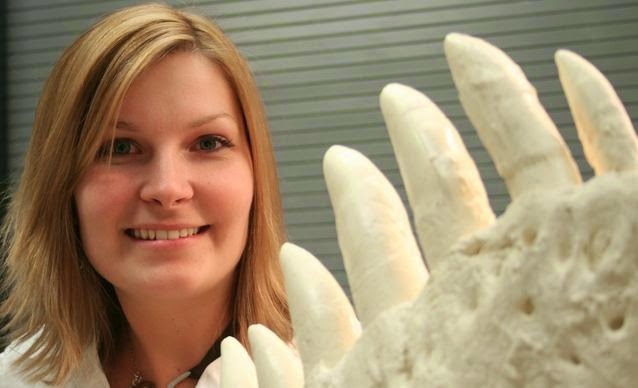
One of the most prominent features of life-size models of Tyrannosaurus rex is its fearsome array of flesh-ripping, bone-crushing teeth.
Until recently, most researchers who studied the carnivore’s smile only noted the varying sizes of its teeth. But University of Alberta paleontologist Miriam Reichel discovered that beyond the obvious size difference in each tooth family in T. rex’s gaping jaw, there is considerable variation in the serrated edges of the teeth.
“The varying edges, or keels, not only enabled T. rex’s very strong teeth to cut through flesh and bone,” says Reichel, “the placement and angle of the teeth also directed food into its mouth.”
Reichel analyzed the teeth of the entire tyrannosaurid family of meat-eating dinosaurs and found T. rex had the greatest variation in tooth morphology or structure. The dental specialization was a great benefit for a dinosaur whose preoccupation was ripping other dinosaurs apart.
Reichel’s research shows that the T. rex’s front teeth gripped and pulled, while the teeth along the side of the jaw punctured and tore flesh. The teeth at the back of the mouth did double duty: not only could they slice and dice chunks of prey, they forced food to the back of the throat.
Reichel says her findings add strength to the classification of tyrannosaurids as heterodont animals, which are animals with teeth adapted for different functions depending on their position in the mouth.
One surprising aspect of T. rex teeth, common to all tyrannosaurid’s, is that they weren’t sharp and dagger-like. “They were fairly dull and wide, almost like bananas,” said Reichel. “If the teeth were flat, knife-like and sharp, they could have snapped if the prey struggled violently when T. rex’s jaws first clamped down.”
Reichel’s research was published in The Canadian Journal of Earth Science.
Journal Reference:
Miriam Reichel, Hans-Dieter Sues. The variation of angles between anterior and posterior carinae of tyrannosaurid teeth. Canadian Journal of Earth Sciences, 2012; 49 (3): 477 DOI: 10.1139/e11-068
Note : The above story is based on materials provided by University of Alberta.










